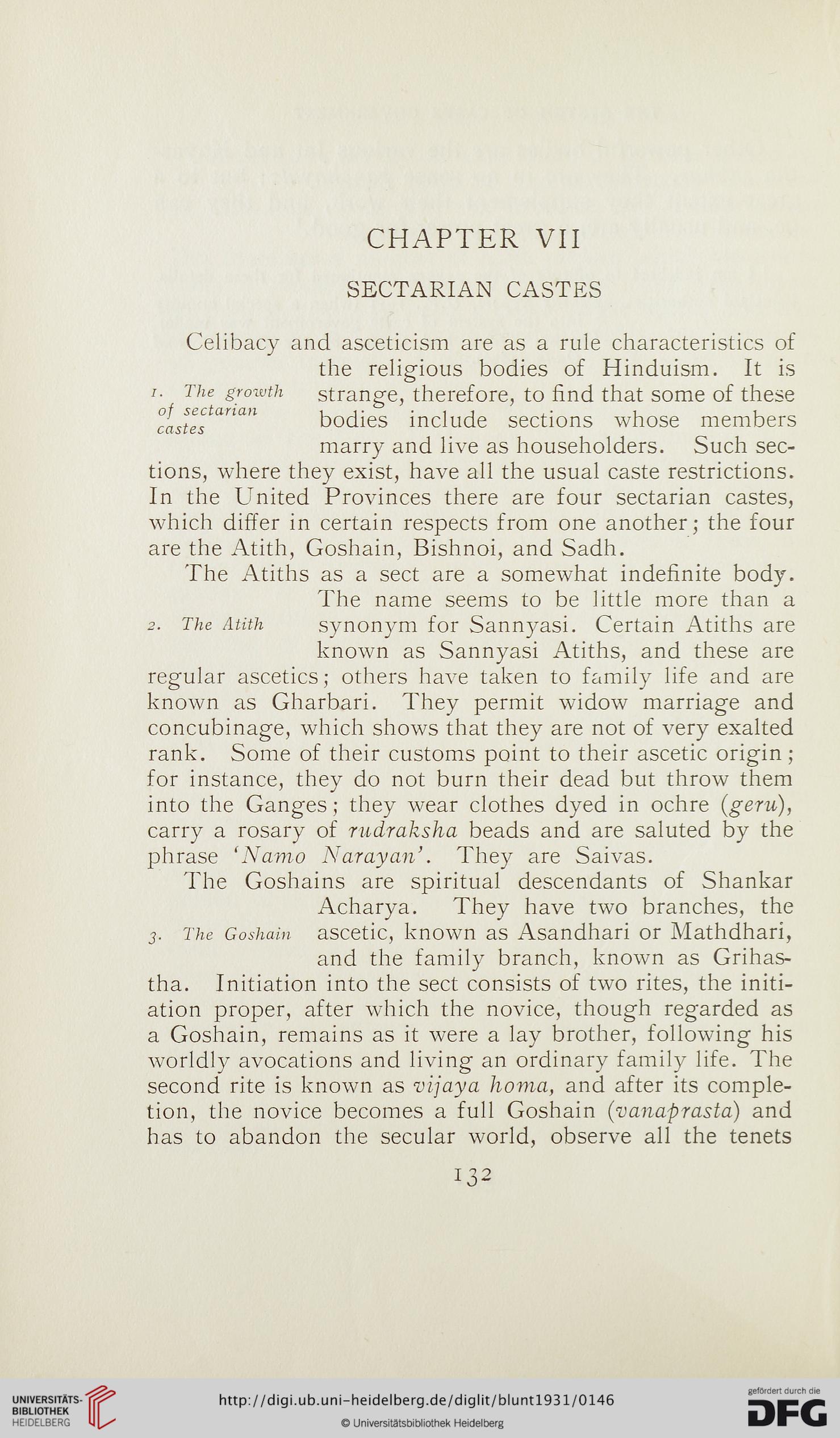CHAPTER VII
SECTARIAN CASTES
Celibacy and asceticism are as a rule characteristics of
the religious bodies of Hinduism. It is
strange, therefore, to find that some of these
bodies include sections whose members
marry and live as householders. Such sec-
tions, where they exist, have all the usual caste restrictions.
In the United Provinces there are four sectarian castes,
which differ in certain respects from one another; the four
are the Atith, Goshain, Bishnoi, and Sadh.
The Atiths as a sect are a somewhat indefinite body.
The name seems to be fittle more than a
2. The Atith synonym for Sannyasi. Certain Atiths are
known as Sannyasi Atiths, and these are
regular ascetics; others have taken to family life and are
known as Gharbari. They permit widow marriage and
concubinage, which shows that they are not of very exalted
rank. Some of their customs point to their ascetic origin;
for instance, they do not burn their dead but throw them
into the Ganges; they wear clothes dyed in ochre (geru),
carry a rosary of rudraksha beads and are saluted by the
phrase ‘Namo Narayan’. They are Saivas.
The Goshains are spiritual descendants of Shankar
Acharya. They have two branches, the
3. The Goshain ascetic, known as Asandhari or Mathdhari,
and the family branch, known as Grihas-
tha. Initiation into the sect consists of two rites, the initi-
ation proper, after which the novice, though regarded as
a Goshain, remains as it were a lay brother, following his
worldly avocations and living an ordinary family life. The
second rite is known as vijaya homa, and after its comple-
tion, the novice becomes a full Goshain (vanaftrasta) and
has to abandon the secular world, observe all the tenets
1. The growth
of sectarian
castes
132
SECTARIAN CASTES
Celibacy and asceticism are as a rule characteristics of
the religious bodies of Hinduism. It is
strange, therefore, to find that some of these
bodies include sections whose members
marry and live as householders. Such sec-
tions, where they exist, have all the usual caste restrictions.
In the United Provinces there are four sectarian castes,
which differ in certain respects from one another; the four
are the Atith, Goshain, Bishnoi, and Sadh.
The Atiths as a sect are a somewhat indefinite body.
The name seems to be fittle more than a
2. The Atith synonym for Sannyasi. Certain Atiths are
known as Sannyasi Atiths, and these are
regular ascetics; others have taken to family life and are
known as Gharbari. They permit widow marriage and
concubinage, which shows that they are not of very exalted
rank. Some of their customs point to their ascetic origin;
for instance, they do not burn their dead but throw them
into the Ganges; they wear clothes dyed in ochre (geru),
carry a rosary of rudraksha beads and are saluted by the
phrase ‘Namo Narayan’. They are Saivas.
The Goshains are spiritual descendants of Shankar
Acharya. They have two branches, the
3. The Goshain ascetic, known as Asandhari or Mathdhari,
and the family branch, known as Grihas-
tha. Initiation into the sect consists of two rites, the initi-
ation proper, after which the novice, though regarded as
a Goshain, remains as it were a lay brother, following his
worldly avocations and living an ordinary family life. The
second rite is known as vijaya homa, and after its comple-
tion, the novice becomes a full Goshain (vanaftrasta) and
has to abandon the secular world, observe all the tenets
1. The growth
of sectarian
castes
132





